|
|
|
Sort Order |
|
|
|
Items / Page
|
|
|
|
|
|
|
| Srl | Item |
| 1 |
ID:
132077
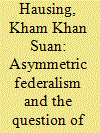

|
|
|
|
|
| Publication |
2014.
|
| Summary/Abstract |
This article intends to fill a glaring void in the existing academic literature on the issues and challenges which stem not only from crafting, but also making asymmetric federalism work in northeast India. It examines the extent and limits to which asymmetric federalism-specifically under Article 371A of India's Constitution-not only negotiates Nagas' sovereignty claims over their land and resources and caters to the demands of democratic justice, but also the extent to which it consolidates India's state-nation and democracy building in its northeastern periphery. Contending that the extant asymmetric federal arrangement in India's polity stems from a centralist federal framework, the article makes a case for a more robust asymmetric federalism, which goes beyond this framework.
|
|
|
|
|
|
|
|
|
|
|
|
|
|
|
|
| 2 |
ID:
095993
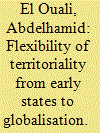

|
|
|
| 3 |
ID:
094696
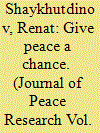

|
|
|
|
|
| Publication |
2010.
|
| Summary/Abstract |
This study examines factors that predict the formation of territorial autonomy arrangements for regionally concentrated ethnic communities. Territorial autonomies are institutional arrangements that allow ethnic groups to express their distinct identities while keeping the borders of host states intact. Although an extensive literature has investigated the capacity of autonomy arrangements to manage interethnic disputes, little research has addressed the precise origins of these institutions. The existing literature considers violent tactics as a primary factor that enables ethnic collectivities to attain territorial autonomy. In this study, the reasoning from the extant literature is juxtaposed with the arguments developed in the research on nonviolent opposition. Nonviolent movements enjoy moral advantage vis-à-vis violent groups. Moreover, peaceful tactics have the advantage of garnering attention for the concerns of ethnic groups without the liability of provoking the animosity or distrust created by violent conflict. Based on the analysis of a dataset representing 168 ethnic groups across 87 states from 1945 to 2000, it is found that the peaceful tactics groups employ when seeking greater self-rule is the single strongest predictor of the formation of autonomy arrangements. In particular, this study concludes that groups that rely on peaceful tactics, such as protests and strikes, and demand territorial autonomy, as opposed to an outright independence, have a greater potential to achieve territorial autonomy in comparison to those groups making extreme demands through the use of violence.
|
|
|
|
|
|
|
|
|
|
|
|
|
|
|
|
| 4 |
ID:
192972
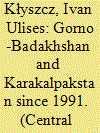

|
|
|
|
|
| Summary/Abstract |
The two Central Asian autonomies of Gorno-Badakhshan and Karakalpakstan have functionally the same competencies as other regions in their respective countries. And yet their autonomous status has persisted. Why? What functions does territorial autonomy carry out in authoritarian states? This paper argues – on the basis of Akchurina’s work of 2019 – that territorial autonomy in Central Asia is a feature of the incomplete state. Namely, territorial autonomy is an institution that sustains informal processes through which state authority is exerted in these challenging territories. The article substantiates this argument by tracing the evolution of centre–region relations in Gorno-Badakhshan and Karakalpakstan since 1991. For Dushanbe, territorial autonomy is a way to symbolically outsource its authority to rebellious local elites, while in Karakalpakstan autonomy allows Tashkent to manage the latent independence claims of the Karakalpaks.
|
|
|
|
|
|
|
|
|
|
|
|
|
|
|
|
| 5 |
ID:
168863
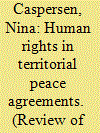

|
|
|
|
|
| Summary/Abstract |
Justice and peace are commonly seen as mutually reinforcing, and key international peacebuilding documents stress the importance of human rights. Is this apparent normative shift reflected in post-Cold War peace agreements? The existing literature is divided on this issue but has crucially treated both conflicts and peace agreements as aggregate categories. This article argues that the conflict type and the agreement's ‘core deal’ impact on the inclusion, or exclusion, of human rights provisions. Based on new coding of the 29 comprehensive agreements signed between 1990 and 2010, it compares agreements signed in territorial and non-territorial conflicts, and agreements with and without territorial autonomy. Qualitative Comparative Analysis is used to examine the different combinations of conditions that led to the inclusion of human rights. The analysis finds that agreements signed in territorial conflicts are significantly less likely to include effective human rights provisions, especially if the settlement includes territorial autonomy. Moreover, such provisions tend to be the result of high levels of international involvement, and the consequent lack of local commitment, or outright resistance, undermines their implementation. These findings point to important trade-offs between group rights and individual rights, and qualifies the notion of a liberal peace.
|
|
|
|
|
|
|
|
|
|
|
|
|
|
|
|
| 6 |
ID:
137221
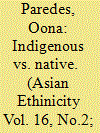

|
|
|
|
|
| Summary/Abstract |
Two categories of ethnic minority – Moro and Lumad – are indigenous to the Philippine island of Mindanao, with Muslim Moros outnumbering largely animist Lumads. Both have been profoundly displaced by the post-World War II influx of Christian Filipino settlers from other islands, leading to armed conflict with the national government over land and political control. Due to their political and demographic inferiority to Moros, Lumads have regularly resorted to the accommodation and assimilation of Moro priorities, including throwing their support behind the latters’ decades-long struggle for territorial autonomy. Thanks to wide public support among the Lumad and other Mindanao sectors, the latest peace talks between the government and Moro leaders has led to the signing of a major peace deal involving the creation of a new autonomous Bangsamoro homeland. Despite this, the legitimate needs of Lumad stakeholders have been ignored, and in some cases deliberately undermined, by Moros and the national government. This article analyses the post-conflict status of the Lumad who, as second-order minorities in the future Bangsamoro homeland, have been doubly marginalized in daily life and in the peace process. It concludes that denying Lumad concerns now will render Bangsamoro more vulnerable to legal and constitutional challenges, as well as jeopardize the unique ‘tri-people’ ethos that has made this the most firmly grounded peace process to date.
|
|
|
|
|
|
|
|
|
|
|
|
|
|
|
|
| 7 |
ID:
127651


|
|
|
|
|
| Publication |
2014.
|
| Summary/Abstract |
Spontaneous and organized population movements have long been used as a means of promoting a country's goals of development and national integration. At the local level, on the other hand, these movements have frequently done the opposite, fueling local grievances, sharpening group distinctions, and at times creating 'sons-of-the-soil' conflicts. In this paper, I explore this apparent tension between the national political rationale for internal migration and the political impact such migration has had locally, in four minority regions of China and Indonesia. I argue that the specific manner in which migration affects local politics is influenced by a country's political regime. In Indonesia, the impact of migration is observed in electoral politics, where 'politics of place' have been allowed to emerge. In China, it is perceived in the curbing of national minorities' territorial autonomy. The role played by local elites and group competition between indigenous people and migrants are also reviewed.
|
|
|
|
|
|
|
|
|
|
|
|
|
|
|
|
| 8 |
ID:
140177


|
|
|
|
|
| Summary/Abstract |
This article evaluates the effect of territorial autonomy on the outbreak of internal conflict by analyzing ethnic groups around the world since WWII. Shedding new light on an ongoing debate, we argue that the critics have overstated the case against autonomy policies. Our evidence indicates that decentralization has a significant conflict-preventing effect where there is no prior conflict history. In postconflict settings, however, granting autonomy can still be helpful in combination with central power sharing arrangements. Yet, on its own, postconflict autonomy concessions may be too little, too late. Accounting for endogeneity, we also instrument for autonomy in postcolonial states by exploiting that French, as opposed to British, colonial rule rarely relied on decentralized governance. This identification strategy suggests that naïve analysis tends to underestimate the pacifying influence of decentralization.
|
|
|
|
|
|
|
|
|
|
|
|
|
|
|
|
| 9 |
ID:
140817


|
|
|
|
|
|
|
|